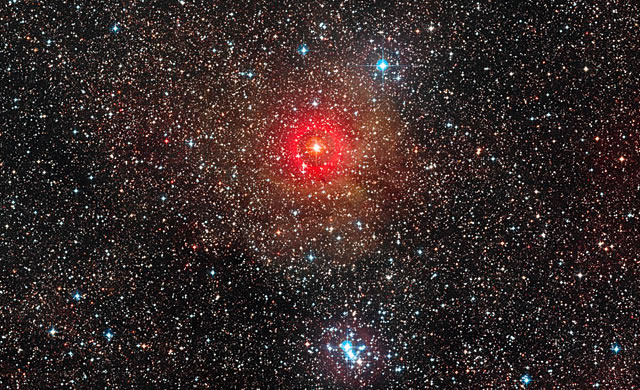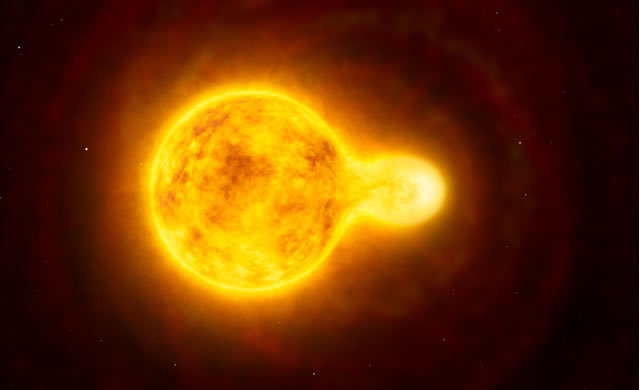
L’Interferometro del VLT (Very Large Telescope Interferometer) ha scovato la più grande stella gialla – e una delle dieci stelle più grandi finora mai trovate. La stella ipergigante ha un diametro più di 1300 volte quello del Sole e fa parte di un sistema stellare doppio, con la seconda componente così vicina da essere in contatto con la stella principale. Le osservazioni, alcune anche da osservatori amatoriali, coprono un intervallo di oltre sessanta anni e indicano che questo oggetto raro e notevole sta cambiando molto rapidamente e viene osservato in una fase molto breve della sua vita.
Utilizzando l’interferemetro del VLT (VLTI) dell’ESO, Olivier Chesneau (Observatoire de la Côte d’Azur, Nizza, Francia), con un gruppo internazionale di collaboratori, ha trovato che la stella ipergigante gialla HR 5171 A è veramente enorme – 1300 volte il diametro del Sole e molto più grande di quanto ci si aspettasse. Questo ne fa la più grande stella gialla conosciuta. È anche nella lista delle dieci più grandi stelle conosciute – del 50% più grande della famosa supergigante rossa Betelgeuse – e circa un milione di volte più brillante del Sole. “Le nuove osservazioni ci hanno anche mostrato che questa stella ha una compagna binaria molto vicina e questo è stato una vera sorpresa”, dice Chesneau. “Le due stelle sono così vicine che si toccano e l’intero sistema assomiglia a una gigantesca arachide.” Gli astronomi hanno sfruttato una tecnica nota come interferometria per combinare la luce raccolta da diversi telescopi singoli, formando di fatto un gigantesco telescopio di dimensione fino a 140 m di diametro. I nuovi risultati hanno spinto l’equipe a studiare a fondo le precedenti osservazioni della stella, per più di sessant’anni indietro, per vedere come si era comportata nel passato. Le ipergiganti gialle sono molto rare – solo una dozzina circa note nella nostra galassia e l’esempio più noto è Rho Cassiopeiae. Sono tra le più grandi e brillanti stelle note e si trovano in una fase della propria vita in cui sono instabili e cambiano rapidamente. A causa dell’instabilità, le ipergiganti gialle espellono materiale verso l’esterno, formando un’atmosfera molto estesa intorno alla stella. Nonostante la grande distanza di circa 12 000 anni luce dalla Terra, l’oggetto può quasi essere visto ad occhio nudo da chi ha una vista molto acuta. Si è visto che HR 5171 A è diventata più grande negli ultimi 40 anni, raffreddandosi mentre cresceva, e la sua evoluzione è stata ora documentata. Solo poche stelle sono state catturate in questa breve fase, mentre subiscono un drastico cambiamento di temperatura durante la veloce evoluzione.
Fonte/Leggi tutto → ESO.org

ESO’s Very Large Telescope Interferometer has revealed the largest yellow star — and one of the ten largest stars found so far. This hypergiant has been found to measure more than 1300 times the diameter of the Sun, and to be part of a double star system, with the second component so close that it is in contact with the main star. Observations spanning over sixty years, some from amateur observers, also indicate that this rare and remarkable object is changing very rapidly and has been caught during a very brief phase of its life.
Using ESO’s Very Large Telescope Interferometer (VLTI), Olivier Chesneau (Observatoire de la Côte d’Azur, Nice, France) and an international team of collaborators have found that the yellow hypergiant star HR 5171 A is absolutely huge — 1300 times the diameter of the Sun and much bigger than was expected. This makes it the largest yellow star known. It is also in the top ten of the largest stars known — 50% larger than the famous red supergiant Betelgeuse — and about one million times brighter than the Sun. “The new observations also showed that this star has a very close binary partner, which was a real surprise,” says Chesneau. “The two stars are so close that they touch and the whole system resembles a gigantic peanut.” The astronomers made use of a technique called interferometry to combine the light collected from multiple individual telescopes, effectively creating a giant telescope up to 140 metres in size. The new results prompted the team to thoroughly investigate older observations of the star spanning more than sixty years, to see how it had behaved in the past. Yellow hypergiants are very rare, with only a dozen or so known in our galaxy — the best-known example being Rho Cassiopeiae. They are among the biggest and brightest stars known and are at a stage of their lives when they are unstable and changing rapidly. Due to this instability, yellow hypergiants also expel material outwards, forming a large, extended atmosphere around the star. Despite its great distance of nearly 12 000 light-years from Earth, the object can just about be seen with the naked eye by the keen-sighted. HR 5171 A has been found to be getting bigger over the last 40 years, cooling as it grows, and its evolution has now been caught in action. Only a few stars are caught in this very brief phase, where they undergo a dramatic change in temperature as they rapidly evolve. By analysing data on the star’s varying brightness, using observations from other observatories, the astronomers confirmed the object to be an eclipsing binary system where the smaller component passes in front and behind the larger one as it orbits. In this case HR 5171 A is orbited by its companion star every 1300 days. The smaller companion is only slightly hotter than HR 5171 A’s surface temperature of 5000 degrees Celsius. Chesneau concludes “The companion we have found is very significant as it can have an influence on the fate of HR 5171 A, for example, stripping off its outer layers and modifying its evolution.”
Source/Continue reading → ESO.org





















